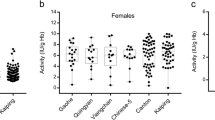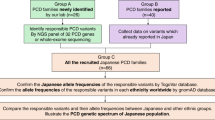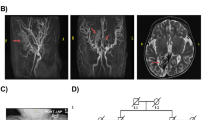Abstract
The most common form of Dopa-responsive dystonia (DRD) is caused by heterozygous mutations in the GTP cyclohydrolase I (GCH1) gene. We screened two unrelated, DRD-symptomatic Chinese Han individuals, for GCH1 gene mutations by direct sequencing. As the clinical manifestations of DRD are highly variable, we also explored the association between genotype and phenotype in all Chinese DRD patients reported so far in the literature, comprising 62 DRD-affected patients from 36 Chinese families. Two novel missense mutations (T94M, L145F) and a novel variant (c. 453+6 G>T) were identified in our two new patients. None of these variants was detected in 200 healthy controls. On the basis of this and other reports, heterozygous mutations were detected in 90.3% of Chinese Han subjects with DRD. Seeming the age of onset for males and females, the mean age was 13 years older in males than in females (P=0.006). Different mutation types did not show any significant differences in age of onset, gender composition, initial symptoms, or the L-dopa dose that abolished the symptoms. Among DRD patients lacking missense or exon–intron boundary mutations, 68.4% were found to possess a large deletion in GCH1, which were detected by multiplex ligation-dependent probe amplification. Most GCH1 mutations were found to cluster in two regions of the coding sequence, suggesting the probable existence of mutation hotspot for the first time. The genotype–phenotype correlation described here may improve our understanding of DRD in Chinese individuals.
Similar content being viewed by others
Log in or create a free account to read this content
Gain free access to this article, as well as selected content from this journal and more on nature.com
or
References
Segawa M, Hosaka A, Miyagawa F, Nomura Y, Imai H : Hereditary progressive dystonia with marked diurnal fluctuation. Adv Neurol 1976; 114: 215–233.
Segawa M, Nomura Y, Nishiyama N : Autosomal dominant guanosine triphosphate cyclohydrolase I deficiency (Segawa disease). Ann Neurol 2003; 54: S32–S45.
Nygaard TG, Marsden CD, Duvoisin RC : Dopa-responsive dystonia. Adv Neurol 1988; 50: 377–384.
Nygaard TG, Takahashi H, Heiman GA, Snow BJ, Fahn S, Calne DB : Long-term treatment response and fluorodopa positron emission tomographic scanning of parkinsonism in a family with dopa-responsive dystonia. Ann Neurol 1992; 32: 603–608.
Asmus F, Gasser T : Dystonia-plus syndromes. Eur J Neurol 2010; 17: 37–45.
Steinberger D, Blau N, Goriuonov D et al: Heterozygous mutation in 5’-untranslated region of sepiapterin reductase gene (SPR) in a patient with dopa-responsive dystonia. Neurogenetics 2004; 5: 187–190.
Bandmann O, Valente EM, Holmans P et al: Dopa-responsive dystonia: a clinical and molecular genetic study. Ann Neurol 1998; 44: 649–656.
Hagenah J, Saunders-Pullman R, Hedrich K et al: High mutation rate in dopa-responsive dystonia: detection with comprehensive GCH1 screening. Neurology 2005; 64: 908–911.
Wu-Chou YH, Yeh TH, Wang CY et al: High frequency of multiexonic deletion of the GCH1 gene in a Taiwanese cohort of dopa-response dystonia. Am J Med Genet Neuropsychiatr Genet 2010; 153B: 903–908.
Cao L, Zheng L, Tang WG et al: Four novel mutations in the GCH1 gene of Chinese patients with dopa-responsive dystonia. Mov Disord 2010; 25: 755–760.
Liu X, Zhang SS, Fang DF et al: GCH1 mutation and clinical study of Chinese patients with dopa-responsive dystonia. Mov Disord 2010; 25: 447–451.
Hu FY, Xu YM, Yu LH, Ma MY, He XH, Zhou D : A novel missense mutation in GTP cyclohydrolase I (GCH1) gene causes dopa-responsive dystonia in Chinese Han population. Eur J Neurol 2011; 18: 362–364.
Wu ZY, Lin Y, Chen WJ et al: Molecular analyses of GCH-1, TH and parkin genes in Chinese dopa-responsive dystonia families. Clin Genet 2008; 74: 513–521.
Abeling NG, Duran M, Bakker HD et al: Sepiapterin reductase deficiency an autosomal recessive DOPA-responsive dystonia. Mol Genet Metab 2006; 89: 116–120.
Steinberger D, Korinthenberg R, Topka H et al: Dopa-responsive dystonia: mutation analysis of GCH1 and analysis of therapeutic doses of L-dopa. Neurology 2000; 55: 1735–1737.
Zirn B, Steinberger D, Troidl C et al: Frequency of GCH1 deletions in Dopa-responsive dystonia. J Neurol Neurosurg Psychiatry 2008; 79: 183–186.
Furukawa Y : Update on dopa-responsive dystonia: locus heterogeneity and biochemical features. Adv Neurol 2004; 94: 127–138.
Steinberger D, Topka H, Fischer D, Müller U : GCH1 mutation in a patient with adult-onset oromandibular dystonia. Neurology 1999; 52: 877–879.
Acknowledgements
This study was supported by a Sichuan Key Project of Science and Technology grant (No. 2010SZ0086) and the National Natural Science Foundation of China (Number 30700243). We thank all the subjects who participated in this study.
Author information
Authors and Affiliations
Corresponding author
Ethics declarations
Competing interests
The authors declare no conflict of interest.
Rights and permissions
About this article
Cite this article
Yu, L., Zhou, H., Hu, F. et al. Two novel mutations of the GTP cyclohydrolase 1 gene and genotype–phenotype correlation in Chinese Dopa-responsive dystonia patients. Eur J Hum Genet 21, 731–735 (2013). https://doi.org/10.1038/ejhg.2012.239
Received:
Revised:
Accepted:
Published:
Issue date:
DOI: https://doi.org/10.1038/ejhg.2012.239



